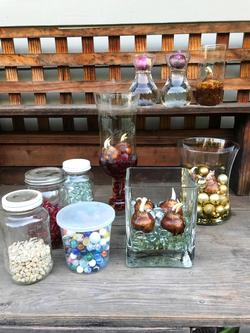To chill, or not to chill, that is the question
-
Jane Scurich
-
Bulbs aren’t only meant for outdoor gardens. With more time at home and a need for live blooming plants to bring cheer to our interiors, now is a great time to explore bulbs for indoor forcing. A number of intriguing bulbs, corms and tubers make wonderful house plants.
 Indoor bulbs are ready to be placed in cool storage
Indoor bulbs are ready to be placed in cool storageWhen planning for indoor bulbs, it’s important to determine whether the bulbs need to be pre-chilled. Most bulbs thrive in areas with freezing temperatures. Our local areas generally do not experience temperatures below 32 degrees for extended periods.
Most of us are familiar with amaryllis and paperwhite narcissus as ideal candidates to fill our homes with holiday color and fragrance. These bulbs are readily available in local garden centers and online. They are easy to plant and almost fail proof. Also, they, along with daffodils and freesias, do not require prechilling.
Prechilling means tricking the bulb to bloom at a time or place where it would not normally be expected to bloom. A temperature of below 50o degrees but not below 30o for 12 - 14 weeks signals the bulb to break dormancy. You can do this with bulbs you purchased early in the fall by placing them in a refrigerator in well-marked paper bags – no plastic bags and no fruit around to release ethanol which can kill the flower in the bulbs. Alternately, you can shop bulb catalogues for prechilled bulbs that will be shipped to you in December, properly chilled, and ready for immediate planting.
How would you like to showcase these little brown packages of energy, just waiting to burst into bloom? Many bulbs do quite well without soil. To best experience the miracle of root development, select a clear glass container with no drainage and prepare a bed of rocks, glass beads, marbles, sea shells, or small tree ornaments. Place the bulbs pointed end up on your chosen medium. Add additional medium around the bulbs so they do not tip over. Add water up to the base of the bulb but no higher to prevent mold or rot. Place the container in a dark, cool area such as a basement, garage cabinet or cool closet. Check water level weekly. Soon you will see roots develop followed by a bit of pale foliage. Move the container to a warmer area with good light and watch the foliage turn a deeper green and bloom stalks appear. Once the blooms start to open, move the container out of direct sun to encourage a longer bloom time.
This technique works well for paperwhites, hyacinths, daffodils, grape hyacinths, crocus and snowdrop. Mix and match for a truly unique and colorful arrangement.
Another method of forcing involves planting non-prechilled bulbs in pots with drainage in well-draining soil at or slightly above soil level. Bulbs can be placed much closer together than you would space in the ground. Place these pots in the coldest area you can find – in a spare refrigerator, a chilly garage, or close to your house’s foundation in the coolest location possible. Cover the pots with a layer of mulch and water when dry. Bulbs are ready to come out of the cold when roots are emerging from the drainage holes and growth is visible on top, somewhere between 10 - 16 weeks. Relocate the pots to a warm sunny spot in your home and enjoy their daily growth and bloom.
Some people compost their forced bulbs after bloom, but if you have the space, you can plant them in the garden. They will probably recover their energy after a season of rest. If the bulbs are in pots with soil, simply place the pots in an out of the way area and let them be summer dry. Next fall, top dress them with some fresh soil, a bit of balanced fertilizer, and restart your chilling process.
Growing bulbs indoors is a great family project and an educational introduction into the vast world of bulbs.

